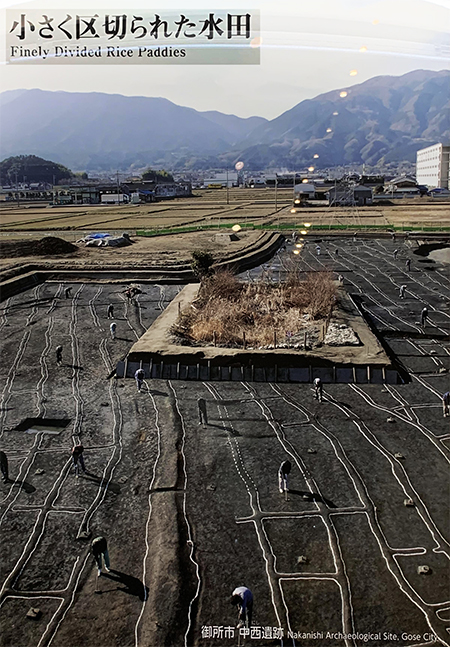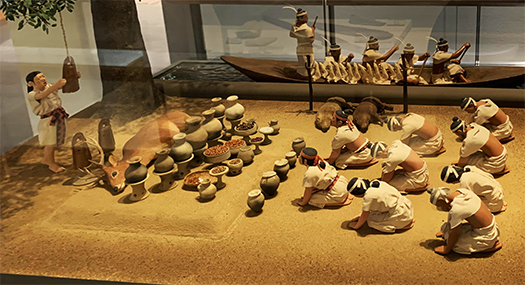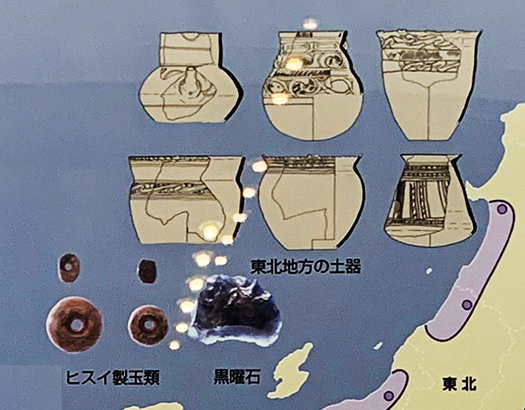

飛鳥板蓋宮の時代とはどのような社会の実相の時代なのか?
現代のこの明日香村地域は過去に都城が作られた首都地域であったのに
その後、そういう王権機能が他所へ移転していって
都城建設に不可欠な土木改編が農村的風景でみごとに被覆されている。
文献史学が有力な根拠を持たない時代相に対して
橿原考古博物館での研究・展示では発掘調査という手法で迫っている。
はるかな北海道からの異邦人としてはそのような解析努力に
深く感謝させられるところです。
展示をまとめた博物館文献資料が存在していないので、
展示からの写真(撮影はフリー)を見ながら想像力を刺激されています。
弥生の社会から王権による「国家」形成への過渡期というのが、
この飛鳥の時代だと思われるのですが、
ひとびとの生産努力は基本的に稲作農業が基盤だった。
稲作社会については特徴的に吉野ヶ里遺跡などで実相が見られる。
吉野ヶ里では、社会が支配と被支配関係が明瞭に伺える。
支配層によって製鉄という稲作農業の基本物資が管理保持され
また、生産物の集積が高倉倉庫群で明瞭に「富の蓄積」として
外形的にも建築表現されている様子がわかると思う。
しかも集落の周囲には「逆茂木」という防衛施設も整備されて
縄文とはまったく異質なシステムで営まれていた様子が表現されていた。
イネという保存性の高い食料がそのまま富の実質表現になり、
そのことが集落間での戦争行為を容易に引き起こさせた状況がわかる。
そういった段階から無数の戦闘が繰り返されていって
この飛鳥の段階になってきたように想像できるのですね。
まさに日本の「ミッシングリンク」がここにあるように思えた。
この段階では、絶えず「治水コントロール」の必要な田んぼ生産施設は
小規模な土木的スパンで運営管理されていたことがわかる。
その分、集団的な支配構造についても強い権力構造が見て取れる。
被支配層は、権力側に土下座させられるような関係性として描かれている。



一方でそのような権力構造がある程度、全国的な権力構造へと
進化拡大していた状況も指し示されている。
たぶん、火山列島社会の日本の特徴として地域的偏差が大きく、
それらがネットワーク的に、モノを介在して交流が拡大していった。
各地からの土器に入れられた生産物が徐々に飛鳥に流入し始めた。
そんな経緯が展示表現に託されているように思われる。
八百万的多様性を基盤にしながらも、ネットワーク的に交流し始めた国家社会。
飛鳥の地で摂政として活躍した聖徳太子さんが
「和を以て貴しとなす」という日本的「民主主義」を宣命していたことの
根拠の社会実相がそこに見えるように思われる。
どうも日本社会はロシア的・大陸的侵略戦争志向型ではない方向で
社会と国家が発展していったといえるのではないか。
English version⬇
[Facts about the country and society “Yayoi-Asuka” Nara / Asuka Search-2]
An exhibition at the Kashihara Archaeological Museum, where evidence of Asuka’s archaeological excavations is collected. The formation of this country that connects Yayoi and Asuka who rise from there.・ ・ ・
What kind of social era is the era of Asuka Itabuki Palace?
This modern Asuka village area was the capital area where Miyakonojo was built in the past.
After that, such a kingship function was transferred to another place.
The civil engineering reorganization that is indispensable for the construction of Miyakonojo is beautifully covered with a rural landscape.
For the times when literature history has no strong basis
In the research and exhibition at the Kashihara Archaeological Museum, we are approaching by the method of excavation.
As a Gentile from far away Hokkaido, such an analysis effort
I am deeply grateful.
Since there is no museum document that summarizes the exhibition,
Imagination is stimulated while looking at the photographs from the exhibition (shooting is free).
The transition period from Yayoi’s society to the formation of a “nation” by the kingship is
I think it was the time of Asuka,
People’s production efforts were basically based on rice farming.
As for the rice-growing society, the actual situation can be seen characteristically at the Yoshinogari ruins.
In Yoshinogari, the relationship between dominance and control of society can be clearly seen.
The ruling class manages and maintains the basic rice farming material called ironmaking.
In addition, the accumulation of products is clearly “accumulation of wealth” in the Takakura warehouse group.
You can see how the architecture is expressed externally.
Moreover, a defense facility called “Abatis” has been developed around the village.
It was expressed that it was operated by a system completely different from the Jomon period.
Rice, a highly conserved food, becomes a real expression of wealth as it is.
It can be seen that this easily caused the act of war between the settlements.
Countless battles have been repeated from that stage
You can imagine that it’s the stage of Asuka.
It seemed like the Japanese “missing link” was right here.
At this stage, the rice field production facilities that constantly require “hydraulic control”
It can be seen that it was operated and managed in a small civil engineering span.
Therefore, a strong power structure can be seen in the collective control structure.
The controlled layer is depicted as a relationship that makes the power side sit down on the ground.
class = “alignnone size-full wp-image-36550” />
On the other hand, such a power structure has become a national power structure to some extent.
The situation that was evolving and expanding is also pointed out.
Probably, the regional deviation is large as a characteristic of Japan in the volcanic archipelago society,
As a network, exchanges expanded through things.
Products in earthenware from all over the world gradually began to flow into Asuka.
It seems that such circumstances are entrusted to the exhibition expression.
A national society that has begun to interact in a network while being based on eight million diversity.
Prince Shotoku, who was active as a regent in the land of Asuka
Having declared the Japanese “democracy” of “to be precious with harmony”
It seems that the social reality of the grounds can be seen there.
Apparently Japanese society is not Russian or continental aggression war oriented
It can be said that society and the nation have developed.
Posted on 4月 17th, 2022 by 三木 奎吾
Filed under: 日本社会・文化研究, 歴史探訪







コメントを投稿
「※誹謗中傷や、悪意のある書き込み、営利目的などのコメントを防ぐために、投稿された全てのコメントは一時的に保留されますのでご了承ください。」
You must be logged in to post a comment.